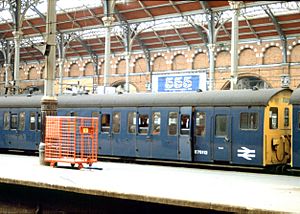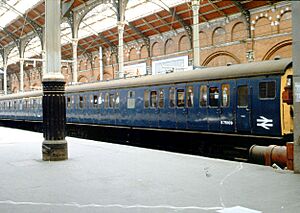British Rail Class 307 facts for kids
Quick facts for kids British Rail Class 307 |
|
|---|---|

British Railways Class 307 train in plain blue livery and a BRUTE at London Liverpool Street station.
|
|
| In service | 1953 - 2000 |
| Manufacturer | BR Eastleigh Works |
| Refurbishment | 1983 - 1984 |
| Number built | 32 Trainset |
| Formation | 4 cars per trainset |
| Operator(s) | British Rail |
| Specifications | |
| Maximum speed | 75mph 121km/h |
| Weight | Total - 153 tons |
| Braking system(s) | Air (Auto/EP) |
The British Rail Class 307 was a type of electric multiple unit (EMU) train. These trains were built by British Rail (BR) at their Eastleigh Works in England. They were made between 1954 and 1956.

Contents
What is a Class 307 Train?
The Class 307 trains were designed to run on electricity. An "electric multiple unit" means that the train is made up of several carriages that can all move on their own using electric power. They don't need a separate engine or locomotive to pull them.
Early Days and Naming
When these trains were first introduced, they had a different name. They were called AM7 trains. Later, a new system was created to name all trains in Britain. This system was called TOPS (Traction Old and New Stock). Under TOPS, the AM7 trains were renamed to Class 307.
Where They Operated
These trains were mainly used on electric railway lines in the south of England. They helped carry passengers on busy routes. The Class 307 trains were known for their reliable service.
Key Features of the Class 307
The Class 307 trains had several important features. They were built to be strong and efficient for passenger transport.
Train Design and Power
Each Class 307 train was made up of four carriages. This allowed them to carry many passengers at once. They could reach a top speed of about 75 miles per hour (121 kilometers per hour). This was a good speed for the railway lines they operated on.
Service Life and Updates
The Class 307 trains were in service for a long time. They started running in 1953 and continued until the year 2000. During their long life, some of the trains were updated. This happened between 1983 and 1984. These updates helped keep the trains working well for many more years.
Images for kids
-
Propelling Control Vehicle, NAA 94308 propelling a train into Plymouth station on 29 August 2003. This vehicle is painted in unbranded Rail Express Systems livery.


